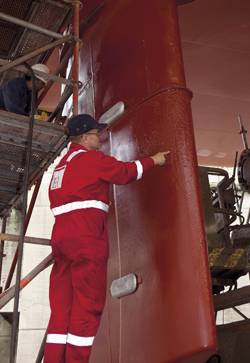Ernst Russ Ends Rudder Cavitation Problems
Founded in 1893 Ernst Russ is a Hamburg based, family owned shipping company. For close to 120 years, Ernst Russ has been offering customers the highest standards in ship management. The ER Fleet Manual, introduced by Ernst Russ long before international standards were developed, is continuously updated and exceeds all standard requirements and regulations. The company has a fleet of ten vessels including five ro-ro cargo ships. Due to their higher propeller revs, the rudders of these ro-ro cargo vessels suffered particularly from cavitation damage. Grzegorz Girjat is Superintendent of Ernst Russ, responsible for the five ro-ro ships. Those ships were built in 1999. The rudders were originally coated with a standard epoxy coating. Grzegorz Giriat explains, “During the first intermediate docking, between two and three years from launch, we observed that we already had extensive cavitation damage on the rudders.” In an attempt to remedy the situation, a special doubler plate was installed on the most affected parts of the rudder. The ships sailed again. “Then it was 2004 when we went to the drydock in Antwerp,” says the Superintendent. “All the vessels were in drydock. The doublers hadn’t helped. I would say the situation worsened a bit because the gap between the hub and the rudder was reduced by the doubler plates. Cavitation is a well-known phenomenon. It’s known there has to be a certain distance between the hub and the rudder. If that distance is not sufficient then the cavitation will be worse.” It was. During that 2004 docking, the glassflake vinylester STC Ecospeed was applied experimentally on the Elisabeth Russ. The application was close to the end of the docking. There was only time to grit blast the rudder and apply two coats of Ecospeed. The pitting and damage from the cavitation was not repaired but the paint simply applied over it. This was the test. The trial was successful beyond all expectations. When the ship next came out of the water in 2007 it could be seen that, despite the last minute application, no further cavitation damage had occurred. As a result, the rudders of the remaining four ro-ro ships were coated with Ecospeed, all with similar results. Based on this the bulbous bows of all the ships were also coated with Ecospeed since these vessels trade in the ice and the traditional coating in use was not holding up in these conditions. The ships have the highest Finnish ice class. Ecospeed has also been used to protect one of the stabilizers. Only budgetary constraints have prevented the company fromblasting the hulls of all five ships and coating them all with Ecospeed. None of the rudders have sustained any further cavitation damage. They have been touched up where the paint was chipped or scraped, but the cavitation damage to the rudders ended with the first application of Ecospeed.














